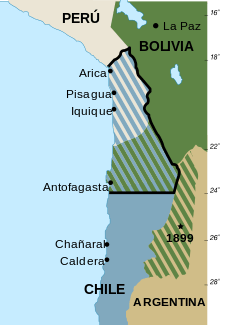Puna de Atacama dispute


The Puna de Atacama dispute, sometimes referred to as Puna de Atacama Lawsuit (Spanish: Litigio de la Puna de Atacama), was a border dispute involving Argentina, Chile and Bolivia in the 19th century over the arid high plateau of Puna de Atacama located about 4500 m.a.s.l. around the current borders of the three countries.[1]
.jpg)
The dispute originated with the Chilean annexation of the Bolivian Litoral Department in 1879 during the War of the Pacific. In 1879 the Chilean Army occupied San Pedro de Atacama, the main settlement of the current Chilean part of Puna de Atacama. By 1884 Bolivia and its ally Peru had lost the war and Argentina communicated to the Chilean Government that the border line in the Puna was still a pending issue between Argentina and Bolivia. Chile answered that the Puna de Atacama still belonged to Bolivia. The same year Argentina occupied Pastos Grandes in the Puna.
Bolivia had still did not signed any peace treaty with Chile until the Treaty of Peace and Friendship of 1904. In the light that influential Bolivian politicians considered the Litoral Province lost for ever, the adjacent Puna de Atacama appeared to be a remote, mountainous and arid place difficult to defend. This prompted the Bolivian government to use it as a tool for to obtaining benefits from both Chile and Argentina. This led to the signature of two contradictory treaties in which Bolivia granted Argentina and Chile overlapping areas. The treaties were the following:
- On May 10, 1889 a secret treaty between the Argentine minister Norberto Quirno Costa and the Bolivian envoy Santiago Vaca Guzmán was signed in Buenos Aires. The treaty established that Argentina renounced to its claims on Tarija in exchange of all the Bolivian Puna de Atacama.
- On May 19, 1891, the Matta-Reyes Protocol was signed between Chile and Bolivia. This protocol recognised the Bolivian territories occupied by Chile since the War of the Pacific as ceded to Chile, including those in the Puna de Atacama, in exchange of defaulting some debts.
On November 2, 1898, Argentina and Chile signed two documents where they decided to convene a conference to define the border in Buenos Aires with delegates of both countries.[2] If there was no accord, a Chilean and Argentine delegate plus the United States minister to Argentina William Buchanan would decide. As foreseen there was no accord at the conference and William Buchanan proceeded together with the Chilean delegate Enrique Mac Iver and the Argentine one José Evaristo Uriburu to define the border.
Of the 75,000 km2 in dispute 64,000 (85%) were awarded to Argentina and 11,000 (15%) to Chile.[2]
References
- ↑ Resende-Santos, Joao (2007). Neorealism, States, and the Modern Mass Army: A Neorealist Theory of the State (hardbound) (illustrated ed.). Cambridge University Press. p. 327. ISBN 978-0-521-86948-5.
- 1 2 (Spanish) Historia de la relacciones exteriores de la Argentina